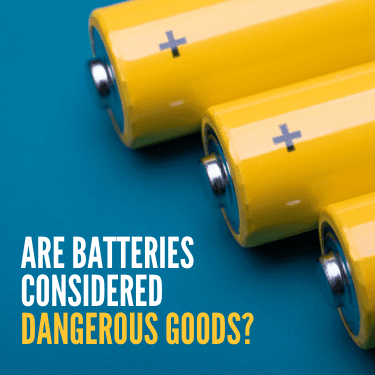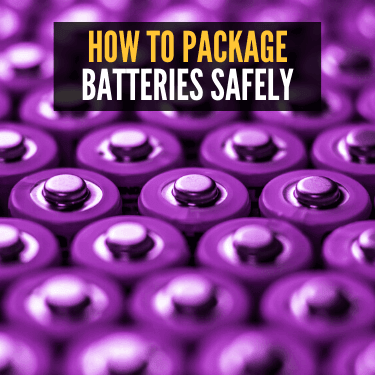Just about everything takes batteries nowadays, so it’s no surprise that these commodities are frequently transported all over the United States. However, there’s more to battery shipping than meets the eye. If you want to ship batteries or battery chargers, you’re going to need to comply with a lot of strict regulations.
Battery shipping entails careful packaging procedures, proper labeling, complying with HazMat regulations, and providing test summary documentation on the health of the batteries being shipped. During shipping, the batteries must be kept cool and dry to prevent leaks.
Like most domestic freight, batteries and battery chargers are often transported on freight trucks. There’s a good reason for this—freight trucks are one of the most affordable options for interstate transportation, and they can still get products delivered just about anywhere in a matter of days. And there’s no shortage of space, since the average freight truck can hold up to 52 stacked pallets at one time!
However, because of the risks a leaky battery could pose to humans, the environment, equipment, and other products, batteries have special handling requirements to ensure they make it to their destination intact.

Batteries are considered especially hazardous when they leak, and they must be treated as dangerous goods in transportation. Batteries are classified as Class 9 Miscellaneous Dangerous Goods since they do not fall under any of the other categories. Working with the best hazmat carriers on the road today will ensure your batteries are handled properly.
Batteries can pose many hazards, including chemical burns, fires, and electrical shocks. Because of this, they are regulated by the Pipeline and Hazardous Materials Safety Administration (PHMSA), under the Department of Transportation (DOT). PHMSA outlines several requirements for shipping lithium batteries that you should know about.
When you have lithium batteries to ship, the first thing you should make sure of is that the batteries have undergone the appropriate safety testing, and that record of that testing can be provided upon request. This report should also contain basic information about the battery itself, its power, and where the testing took place.
In addition to that, your carrier will need to be provided with shipping documents that communicate the hazard of the shipment, and what actions should be taken in the event of a leak. They will also need to be certified to transport hazardous materials, which not all carriers are. In fact, any employee that will be involved in the transport or handling of batteries needs to be hazmat trained.
Many of the regulations refer to how batteries are packaged and labeled.

If lithium batteries are not packaged correctly, they can overheat and ignite, which results in a rapidly spreading fire that can quickly get out of control. Burning batteries release harmful gases into the air, which can seriously hurt anyone nearby. Handling or shifting around due to improper packaging can result in damages to the battery casing, which can also have serious consequences.
For these reasons, batteries have very strict packaging requirements. Here are some things to note before you get started:
In order to prevent shifting around during shipping, batteries must be encased in several layers of packaging. Each battery must be wrapped in a cushioning primary packaging, that both protest the batteries from impact, and keeps them separate from each other. Then, those batteries should be placed in a rigid secondary package to protect them from being crushed. Additional packaging between batteries can also be used to reduce empty space and decrease the likelihood of the batteries ever coming into contact with each other.
Once the batteries are packaged, they must undergo a “drop test,” in which the package is tested to see if it can withstand a drop—from any angle—at a height of 1.2 m. If any of the batteries shift after the drop test, then the packaging is not sufficient.
Once the batteries are packaged, you’ll need to label them properly so the boxes communicate the hazards they contain.
Lithium batteries have their own illustrated label that specifically identifies them (called a “handling mark”), though you should also include the standard Hazard Class 9 identification sticker on the package as well. That label is black and white, and sometimes also has the battery illustration on it as well. These labels should be applied on one side of each package, as close to the UN number as possible. They should be easy to see, and the corners should never be folded around the edge of the box.
When positioning the hazard label, make sure you have it positioned on the point with the number on the bottom. The number at the bottom should be upright—if it isn’t, then you don’t have it positioned right.
Battery shipping is no easy task, but with R+L Global Logistics on your side, you’ll be able to get your shipment compliant and on the road in no time! If you want the peace of mind associated with working with a certified HazMat carrier, then look no further! Our carrier partners are some of the most trustworthy truckers in the industry, and our 99.5% on-time delivery record is proof of their achievements. Plus, by working with us, you can take advantage of the following benefits:
Work with R+L Global Logistics for your battery shipping and battery charger shipping needs! Request a freight quote, or give us a call for more information at (866) 353-7178.
R+L Global Logistics
315 NE 14th St., Ocala, FL 34470